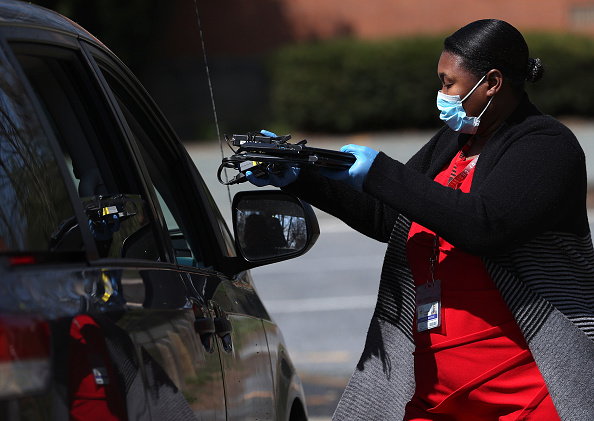
Staff members at Woodlin Elementary School distribute computers to parents of Montgomery County students who do not have them March 26, 2020 in Silver Spring, Maryland. Photo credit: Win McNamee, Getty Images
Nearly one third of parents plan to keep their kids at home this fall, according to a survey published in JAMA Pediatrics. Though the fall semester has already begun in some states, many districts are still grappling with the specifics of how they will host classes in-person or online.
In the survey of 730 parents, 31% said they would probably or definitely keep their child at home, even if schools were open for in-person instruction. Another 49% said they would send their kids to school.
Whether parents were working full-time or had a flexible job was also a significant factor in their response.
40% of unemployed parents said they would keep their children at home, compared to 26% of employed parents. And 33% of parents with flexible jobs planned to keep kids at home, compared to 19% of those with inflexible jobs.
Overall, 57% of employed respondents said they could work from home, and 44% said they had flexible work hours.
At the same time, parents also worried about family members in their household getting sick from Covid-19, or that their kids might develop multisystem inflammatory syndrome — a rare, but serious condition associated with Covid-19. Of the parents that were surveyed, 34% said they had at least one medically vulnerable person living in their household.

A Deep-dive Into Specialty Pharma
A specialty drug is a class of prescription medications used to treat complex, chronic or rare medical conditions. Although this classification was originally intended to define the treatment of rare, also termed “orphan” diseases, affecting fewer than 200,000 people in the US, more recently, specialty drugs have emerged as the cornerstone of treatment for chronic and complex diseases such as cancer, autoimmune conditions, diabetes, hepatitis C, and HIV/AIDS.
Notably, just 29% of parents were confidence that their school could prevent the spread of Covid-19, and just 35% thought their school could provide enough social activity for their child while maintaining social distancing. More parents, roughly 45%, thought schools could meet their child’s academic needs with a modified schedule.
As the school year begins, many districts are still working through the finer points of their plans for the fall.
California’s largest school districts, Los Angeles Unified School District and San Diego Unified, plan to start off the year with distance learning. Schools located in counties on the state’s watchlist for high Covid-19 cases must have classes remotely, but even though San Diego was recently taken off the watchlist, San Diego Unified said it would take months to return to in-person learning.
Other states are moving forward with in-person learning. In Georgia, 1,200 students and staff members had to quarantine after Cherokee County School District opened for in-person classes in August. Statewide, it’s up to the districts to decide whether or not to offer in-person classes.













